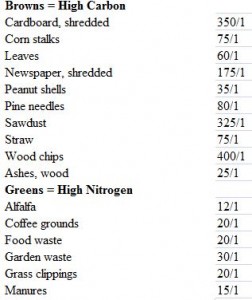Compost
Compost is what happens when formerly living things decompose. It’s incredibly easy to make compost. Set living things aside to rot. When they’ve decomposed, you’re done!
Compost can be produced faster by managing a more complex process. Gardeners manipulate the decomposition process to create an abundance of compost quickly.
Compost has several benefits:
* It’s rich and adds vital nutrients to soil and therefore plants.
* It improves soil texture. Clay soil is loosened by the addition of compost.
* Compost feeds soil microorganisms. These helpers also add nutrients to soil.
* It creates an environment that allows precious water to more effectively reach plants.
* The addition of compost as mulch around the base of plants shades the plants and reduces watering needs.
* Compost makes an outstanding potting soil ingredient.
Compost can be made anywhere. Many put materials in a pile; others in a bin. Still others use sheet composting, which also has been called lasagna gardening. Sheet composting can be done as mulch around plants. Or you can build the sheets on your existing garden plot. Or you can start a new garden plot by building your lasgana garden there.
To make a compost pile that heats up is optimal for many gardeners. Heat kills weed seeds and produces compost much more quickly than materials that decompose without intervention. To get a pile to heat up requires attention to the size and the contents of the pile. The pile must have enough mass and the correct ratio of “browns” and “greens.” It must have the correct moisture and air content and the pile must be turned.
The compost pile’s microbial critters do the work for us. Bacteria start the process of decaying organic matter. They initiate the breakdown of plant tissue. They are the most numerous and effective composters. Fungi and protozoans soon join the bacteria and, somewhat later in the cycle, centipedes, millipedes, beetles and earthworms join the party.
Carbon and nitrogen, from the cells of dead plants and dead microbes, fuel the composting activity. The micro organisms use carbon as an energy source. Nitrogen provides the microbes with the raw element of proteins to nourish their bodies.
Everything organic has a ratio of carbon to nitrogen (C:N), ranging from 325:1 for sawdust, to 20:1 for table scraps. A C:N ratio of 30:1 is ideal for the activity of compost microbes. This balance can be achieved by mixing two parts grass clippings (which have a C:N ratio of 20:1) with one part fallen leaves (60:1) in your compost. Other materials can also be used, such as weeds and garden wastes. A C:N ratio of 30:1 is ideal for a fast, hot compost. A higher ratio (i.e., 50:1) will result in a slower compost. Below is a table that provides a ratio of some materials.

Compost materials with a high nitrogen content are often referred to as “greens”. Grass clippings, kitchen vegetable waste, and manure are common greens. High carbon materials are “browns”, and include sawdust, dried leaves and hay.
A complete mixing of ingredients is preferable for the composting process. Composting will work a bit slower if the pile stays layered.
The more surface area the micro organisms have to work on, the faster the materials are decomposed. Chopping your garden wastes or running them through a shredding machine or lawnmower will speed their composting.
A large compost pile will insulate itself and hold the heat of microbial activity. Its center will be warmer than its edges. Piles smaller than 3 feet cubed will have trouble holding this heat, while piles larger than 5 feet cubed don’t allow enough air to reach the microbes at the center. Keep your pile between these two sizes if your goal is a fast, hot compost.
The pile will decompose best when the compost materials are about as moist as a wrung-out sponge, and are provided with many air passages. Environmental situations of hot sun or abundant rain can affect the moisture balance in your pile.
If your compost has a bad odor, your pile is not getting enough air. Turn the pile or add coarser materials to provide more air exposure.
If your pile is damp and smells like sweet compost, but it will not heat up – it means your pile does not have enough nitrogen. Mix in some greens i.e. grass clippings, manure, or bloodmeal.
When you’ve made compost, congratulate yourself on making a valuable treasure.
Making compost in a plastic bin that can be rolled is a method that is very easy. Many gardeners use this method.
Another thing you can do is with compost is make a compost tea and use this to fertilize plants. Place compost in a piece of burlap or cloth fabric and tie it closed. Put in a bucket and add water. Swish the bag of compost around. Let is sit for an hour or two, swish some more and your tea is made. Water plants with this tea. The remaining compost in the bag can still be used as normal.
Compost is a wonderful soil amendment!

